Ananda Mahidol
| Ananda Mahidol | |
|---|---|
| King Rama VIII | |
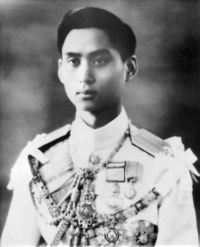 |
|
|
|
|
| Reign | 2 March 1935 – 9 June 1946 (11 years, 99 days) |
| Predecessor | Prajadhipok (Rama VII) |
| Successor | Bhumibol Adulyadej (Rama IX) |
| Regent | Regency Council (1935-1944) Pridi Banomyong (1944 -1946) |
| Prime Ministers |
See list
Phot Phahonyothin
Plaek Pibulsonggram Khuang Abhaiwongse Tawee Boonyaket Seni Pramoj Pridi Banomyong |
| House | House of Mahidol Chakri Dynasty |
| Father | Prince Mahidol Adulyadej, Prince of Songkhla |
| Mother | Srinagarindra |
| Born | 20 September 1925 Heidelberg, Germany |
| Died | 9 June 1946 (aged 20) Bangkok, Thailand |
| Religion | Theravada Buddhism |
Phra Bat Somdet Phra Poramentharamaha Ananda Mahidol Phra Atthama Ramathibodindara (Thai: พระบาทสมเด็จพระปรเมนทรมหาอานันทมหิดลฯ พระอัฐมรามาธิบดินทร; RTGS: —Ananthamahidon Phra Atthamaramathibodin), or Rama VIII (20 September 1925–9 June 1946) was the eighth monarch of Thailand under the House of Chakri.
Contents |
Early life
Prince Ananda Mahidol Mahidol (Mom Chao Ananda Mahidol Mahidol — หม่อมเจ้า อานันทมหิดล มหิดล) was born in Heidelberg, Germany. He was the first son of Prince Mahidol Adulyadej of Songkhla (son of King Chulalongkorn) and Mom Sangwal (last title Somdej Phra Sri Nakarindhara Boromaratchachonnani) who were studying there at the time. King Vajiravhud, his uncle, sent a telegram on 13 October 1925 auspiciously naming him "Ananda Mahidol" (อานันทมหิดล), meaning "the joy of Mahidol". ("Ananda Mahidol" is one word and is his first name. It is pronounced "Ananta Mahidon". When he held his birth rank of "Mom Chao" -- the lowest rank of Thai princes—he used the surname of "Mahidol" from his father; his name at this point was thus "Mom Chao Ananda Mahidol Mahidol").
He followed his parents to Paris, Lausanne, and then to Massachusetts when, in 1927, another uncle, King Prajadhipok issued a royal edict exalting him to the higher princely class of Phra Worawong Ther Phra Ong Chao. (This edict also benefited other "Mom Chao" who were the children of Chao Fa and their commoner wives, among them his elder sister Mom Chao Galyani Vadhana and his younger brother who, upon his birth later in the year, was born Phra Worawong Ther Phra Ong Chao Bhumibol Adulyadej).
The family returned to Thailand in 1928 after Prince Mahidol finished his medical studies at Harvard University. Prince Mahidol died at age 37 in 1929, when Ananda Mahidol was just 4 years old. His widowed mother was thus left to raise her family alone.
A coup d'état in 1932 ended the absolute monarchy and raised the possibility that King Prajadhipok might abdicate. Queen Savang Vadhana, his grandmother, was concerned about Prince Ananda Mahidol's safety, since he was one of the likely heirs to the throne. It was then suggested that the Mahidol family again move to Lausanne. The official reason given was for the health and further education of the princes. They left Thailand in 1933 and Prince Ananda Mahidol spent most of his youth in Switzerland.
However, when King Prajadhipok's abdication appeared imminent, the Prince's mother was approached by a member of government, asking for her opinion about Ananda Mahidol becoming the next Thai monarch.
Circumstance of succession
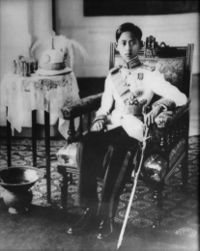
See also King Prajadhipok's circumstance of succession
King Prajadhipok (Rama VII) abdicated in 1935 due to political quarrels with the new quasi-democratic government as well as health problems. The King decided to abstain from exercising his prerogative to name a successor to the throne. By that time, the crown had already passed from Prince Mahidol's line to that of his half-brothers when his eldest full brother, Crown Prince Maha Vajirunhis, died as a teenager during King Chulalongkorn's reign. A half-brother, Prince Vajiravudh (as the next eldest) replaced Prince Vajirunhis as the Crown Prince he eventually succeeded to the throne in 1910 as King Rama VI. In 1924 the King instituted the Palace Law of Succession in order to govern subsequent successions. The law gave priority to the children of his mother Queen Regent Saovabha Bongsri over the children of King Chulalongkorn's two other royal wives. The law was enact on the death of King Vajiravudh in 1925 — the crown was passed to his youngest brother, Prince Prajadhipok of Sukhothai.
Offering the throne to Prince Prajadhipok was not without a debate. In doing so, another candidate was bypassed: Prince Chula Chakrabongse, son of the late Field Marshal Prince Chakrabongse Bhuvanat of Phitsanulok, who before his death had been the heir-apparent to King Vajiravhud. It was questioned whether the Succession Law enacted by King Vajiravhud actually barred Prince Chakrabongse Bhuvanat (and for that matter, Prince Chula Chakrabongse) from succession on the ground that he married a foreigner (Russian). However, his marriage took place before this law was enacted and had been endorsed by King Chulalongkorn himself. There was no clear resolution, but in the end the many candidates were passed over and Prince Prajadhipok was enthroned.
When King Prajadhipok later abdicated, since he was the last remaining son of Queen Saovabha, the crown went back to the sons of the Queen whose rank was next to hers: Queen Savang Vadhana, mother of the late Crown Prince Vajirunahis. Besides the late Crown Prince, she had two more sons who survived to adulthood: Prince Sommatiwongse Varodaya of Nakhon Si Thammarat, who had died without a son in 1899, and Prince Mahidol who, although deceased, had two living sons. It thus appeared that Prince Ananda Mahidol would be the first person in the royal line of succession.
Nevertheless, the same debate over the half-foreign Prince Chula Chakrabongse occurred again. It was argued that King Vajiravhud had virtually exempted the Prince's father from the ban in the Succession Law, and the crown might thus be passed to him.
However since the kingdom was now governed under a constitution, it was the Cabinet who would decide. Opinion was split on the right to succession of Prince Chula. A key figure was Pridi Phanomyong, who persuaded the Cabinet that the Law should be interpreted as excluding the Prince from succession, and that Prince Ananda Mahidol should be the next king. It also appeared more convenient for the government to have a monarch who was only 9 years old and was attending school in Lausanne, Switzerland. On 2 March 1935 Prince Ananda Mahidol was elected by the National Assembly of Siam and government to succeed his uncle, King Prajadhipok as the Eight King of the Chakri Dynasty.
Life as King
As the new King was still a child and was then studying in Switzerland, the parliament appointed Colonel Prince Anuwatjaturong, Lieutenant Commander Prince Artit Thip-apa, and Chao Phraya Yommaraj (Pun Sukhum) as his regents.
In 1938, at age 13, Ananda Mahidol visited the Kingdom of Siam for the first time as monarch. He was accompanied during his visit by his mother and his younger brother Bhumibol Adulyadej. Field Marshal Plaek Pibulsonggram (sometimes simply called "Pibun") was the Prime Minister at this time and during most of Ananda Mahidol's reign. Pibulsonggram was a military dictator and, in 1939, he arranged to change the name of the country from Siam to Thailand. Late in 1940, Pibulsonggram involved Thailand in the indecisive "Franco–Thai War" against the Vichy forces in French Indochina.
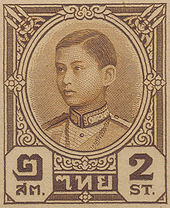
World War II
On 8 December 1941, in concert with the attack on Pearl Harbor, Japanese forces invaded and occupied Thailand. Ananda Mahidol was away from the country and Pridi Phanomyong served as regent in his absence. From 24 January 1942, occupied Thailand became a formal ally of the Empire of Japan and a member of the Axis. Under Plaek Pibulsonggram, Thailand declared war on the Allied powers. During the war, many members of the Thai Government, including the Ambassadorial staff in Japan acted as 'de-facto' spies on the side of the Allies, funneling secret information to the OAS.
By 1944, it was becoming apparent that the Japanese were going to lose the war to the Allies. Bangkok suffered heavily from the Allied bombing raids. This, plus economic hardship, made both the war and the regime of Plaek Pibulsonggram very unpopular. In July, Plaek Pibulsonggram was ousted by the Seri Thai-infiltrated government. The National Assembly reconvened and appointed the liberal lawyer Khuang Aphaiwong as Prime Minister. The Japanese surrendered on 15 August 1945. The Allied military responsibility for Thailand fell to the British.
Post war
Only after the end of World War II did Ananda Mahidol return to Thailand. He returned for a second visit in December 1945 with a degree in Law. Despite his youth and inexperience, he quickly won the hearts of the Thai people, who had continued to revere the monarchy through the upheavals of the 1930s and 1940s. He was a handsome young man and Thais were delighted to have their King amongst them once again. One of his well-remembered activities was a highly successful visit to Bangkok's Chinatown, which was calculated to defuse the post-war tensions that lingered between the ethnic Chinese and the Thais.
Foreign observers, however, believed that Ananda Mahidol did not really want to be King and felt his reign would not last long. Louis Mountbatten, Earl Mountbatten of Burma, the British commander in South-East Asia, visited Bangkok in January 1946 and described the King as "a frightened, short-sighted boy, his sloping shoulders and thin chest behung with gorgeous diamond-studded decorations, altogether a pathetic and lonely figure." At a public function, Mountbatten wrote, "his nervousness increased to such an alarming extent, that I came very close to support him in case he passed out."
A mysterious death
On 9 June 1946, the King was found shot dead in his bedroom in the Boromphiman Throne Hall, (a modern residential palace located within the Grand Palace), only four days before he was scheduled to return to Switzerland to finish his doctoral degree in Law at the University of Lausanne. His brother Bhumibol Adulyadej succeeded him. Ananda Mahidol was never crowned as king, but his brother posthumously gave him the full royal title of the ninefold umbrella.
Events of 9 June 1946
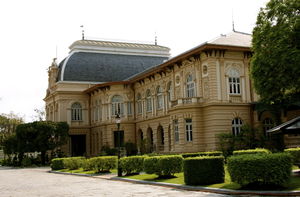
Keith Simpson, pathologist to the British Home Office and founding chairman of the Department of Forensic Medicine at Guy's Hospital in London, performed a forensic analysis of the King's death and recounted the following sequence of events on the morning of 9 June 1946:[1]
King Ananda was woken by his mother at 6am.
At 7.30am, his page But Pathamasarin came on duty and began preparing a breakfast table on a balcony adjoining the king's dressing room.
At 8.30, But saw the king standing in his dressing room. He brought the king his customary glass of orange juice a few minutes later. However, by then the king had gone back to bed and refused the juice.
At 8.45am, the king's other page Chit Singhaseni appeared, saying that he had been called to measure the King's medals and decorations on behalf of a jeweller who was making a case for them.
At 9am, Prince Bhumibol visited King Ananda. He said afterwards that he had found the king dozing in his bed.
At 9.20am, a single shot rang out from the king's bedroom. Chit ran in and then ran out along the corridor to the apartment of the king's mother, crying "The King has shot himself!"
The king's mother followed Chit into the king's bedroom and found the king lying face up in bed, bloodied from a wound to the head.
Aftermath
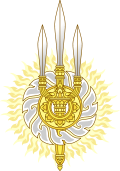 |
|
| Buddha Yodfa Chulaloke | |
| Buddha Loetla Nabhalai | |
| Jessadabodindra | |
| Mongkut | |
| Chulalongkorn | |
| Vajiravudh | |
| Prajadhipok | |
| Ananda Mahidol | |
| Bhumibol Adulyadej | |
An initial radio announcement on 9 June surmised that the King was accidentally killed while toying with his pistol.[2]
Soon after the death, the Democrat Party spread rumors that Pridi Banomyong was behind the death.[3]
In October 1946, a Commission of Inquiry reported that the King's death could not have been accidental, but that neither suicide nor murder was satisfactorily proved.
In November 1947, Field Marshal Plaek Pibulsonggram staged a coup against the elected government of Pridi, appointed Democrat Party leader Khuang Aphaiwong as Prime Minister, and ordered a trial. King Ananda's secretary, Senator Chaleo Patoomros, and the pages, But and Chit, were arrested and charged with conspiracy to kill the King.
The trial began in August 1948. Prior to the trial, Plaek admitted to US Ambassador Edwin Stanton that he was doubtful that the trial would resolve the mystery of Ananda Mahidol's death.[3] The prosecution's case was supported by 124 witnesses and such voluminous documentary evidence that the defense counsel asked for an adjournment to give them time to consider it. When this was refused the counsel resigned, and new counsel were found. Later, two of the defense counsel were arrested and charged with treason. Of the remaining two, one resigned, leaving only a single young lawyer for the defence, Fak Na Songkhla. Towards the end of the case, he was joined by Chaleo Patoomros's daughter, who had just graduated.
The trial ended in May 1951. The court found that King Ananda had been assassinated, but that Chaleo had not been proved guilty and that neither of the pages could have fired the fatal shot. However, they found Chit guilty of being a party to the crime. The charges against Chaleo and But were dismissed and the two released.
Chit appealed his conviction, and the prosecution appealed against the acquittal of Chaleo and But. After fifteen months of deliberation, the Appeal Court dismissed Chit's appeal, and undeterred by the legal doctrine of double jeopardy found But guilty also.
Chit and But appealed to the Supreme Court, which deliberated for ten more months before finally upholding both convictions, and this time convicting Chaleo as well.
In February 1955, Chaleo Patoomros and the two pages were executed by Pibulsonggram's government on charges of conspiracy to kill the King.
Alternative explanations of the death
The King's death is still seen as a mystery. The subject is never openly discussed in Thailand. With the exception of Bhumibol Adulyadej, all the principals related to the death already died.
Bhumibol Adulyadej
On 15 June 1946, American Charge d'Affaires Charles W. Yost met with Foreign Minister Direk Jayanama, who had just had a audience with the new King, Bhumibol Adulyadej. In his report to the US State Department, Yost noted
King Phumiphol... informed the Foreign Minister that he considered [the widely circulated] rumors [on the late King's death] absurd, that he knew his brother well and that he was certain that his death had been accidental... What the King said to Direk does not necessarily represent what he really believes, it is nevertheless interesting that he made so categorical a statement to the Foreign Minister.[3]
However, in an 1980 BBC documentary, Bhumibol claimed that the death was not an accident. He noted in English:
The investigation provided the fact that he died with a bullet wound in his forehead. It was proved that it was not an accident and not a suicide. One doesn’t know. . . . But what happened is very mysterious, because immediately much of the evidence was just shifted. And because it was political, so everyone was political, even the police were political, [it was] not very clear. I only know [that] when I arrived he was dead. Many people wanted to advance not theories but facts to clear up the affair. They were suppressed. And they were suppressed by influential people in this country and in international politics.[4]
Seni Pramoj and the Democrat Party
Seni Pramoj and the Democrat Party spread rumors that Pridi was behind the death. Yost noted in a US State Department communication
"...Within forty-eight hours after the death of the late King two relatives of Seni Pramoj, first his nephew and later his wife, came to the Legation and stated categorically their conviction that the King had been assassinated at the instigation of the Prime Minister [Pridi Banomyong]. It was of course clear that they had been sent by Seni. I felt it necessary to state to both of them in the strongest terms, in order to make it perfectly clear that this Legation could not be drawn into Siamese political intrigues, that I did not believe these stories and that I considered the circulation at this time of fantastic rumors un-supported by a shred of evidence to be wholly in-excusable. The British Minister informed me this morning that he had also been approached by several members of the Opposition to whom he had stated that he accepted the official account of the King's death and that he would not be drawn into any further discussion of the matter.[3]
Pridi Banomyong
On 14 June 1946, Yost met with Pridi Banomyong and made the following report to the US State Department:
"[Pridi spoke] very frankly about the whole situation and ascribed the King's death to an accident, but it was obvious that the possibility of suicide was at the back of his mind. [Pridi] was violently angry at the accusations of foul play leveled against himself and most bitter in the manner in which he alleged (without doubt justly) that the Royal Family and the Opposition, particularly Seni Pramoj and Phra Sudhiat, had prejudiced the King and especially the Princess Mother against him."[3]
Plaek Pibulsonggram
After overthrowing Pridi Banomyong in a coup, Field Marshal Plaek Pibulsonggram told US Ambassador Edwin Stanton that he "personally doubted whether Nai Pridi was directly involved for two reasons: firstly, ... Pridi is a very clever politician and secondly, ... he has a "kind heart"." Pibul concluded to the Ambassador that that "he did not think [Pridi] would cause anybody to be murdered. Pibul's wife, present in the meeting, seconded her husband's observations. However, Pibul noted that it was possible that Pridi had covered up or destroyed some of the evidence to protect the successor, Bhumibol Adulyadej.[3]
Keith Simpson
Dr. Keith Simpson, a forensic pathologist who investigated the King's death found it highly unlikely that the death was due to suicide, noting that:
- The pistol was found by the King's left hand, but he was right-handed.
- The direction of bullet fired was not inward towards the centre of the head.
- The wound, over the left eye, was not in one of the elective sites, nor a "contact" discharge.
- The King was killed while lying flat on his back. Simpson noted that in twenty years' experience he never known of any suicide shooting himself whilst lying flat on his back.[1]
William Stevenson
An account of the death is given in William Stevenson's The Revolutionary King, written with the co-operation of King Bhumibol Adulyadej. This account exculpates those executed and suggests that Ananda Mahidol was murdered by Tsuji Masanobu. Tsuji was a former Japanese intelligence officer who had been active in Thailand during the war and, at the time of Ananda Mahidol's death, was hiding out in Thailand over fear of being persecuted for his war crimes.
It is clear from Stevenson's account that Ananda Mahidol cannot have killed himself, either by suicide (as is sometimes suggested) or accidentally. He was found lying on his back in his bed, not wearing his glasses, without which he was almost blind. He had a small bullet wound in his forehead and a somewhat larger exit wound in the back of his head. His pistol, a Colt .45 given to him as a gift by a former US Army officer, was not nearby. The Colt .45 is known to be not prone to accidental discharge; it will fire only if considerable pressure is applied to the safety plate at the back of the butt at the same time as the trigger is depressed. The Colt is also a heavy pistol and difficult to use by a person without training. It is reasoned that it would have been virtually impossible for Ananda Mahidol, a frail 20-year-old, to lie on his back and shoot himself in the forehead with such a pistol. If he had done so, the impact, according to forensics experts, would have blown his skull apart, not caused the small wound seen by many witnesses. Stevenson writes that no cartridge case was found, and subsequent inquiries ordered by King Bhumibol, but suppressed by later governments, found that the Colt had not been fired.[5]
Rayne Kruger
Another account, which concluded that Ananda Mahidol's death was the result of suicide, was explored by journalist Rayne Kruger in his book, The Devil's Discus[6] The book is banned in Thailand. However, a website[7] by a Thai writer has provided a summary of Kruger's arguments, and it links to other material about the death.
In memoriam
- Figure 1: 1959 statue of Ananda Mahidol, erected in Wat Suthat, Bangkok, by King Bhumibol Adulyadej as a tribute to his brother.
- Figure 2: 2002 Rama VIII Bridge across the Chao Phraya River.
- Figure 3: 2003 back of 20-baht banknote, Bridge in background behind portrait of King Ananda Mahidol; to the left, the king, shaded by a royal umbrella, is followed on his right and one step behind by his brother with his ever-present camera. Design date 12 February 2546 BE/AD 2003.
- Figure 4: Detail of legend at lower right. Translation: If all Thai people know they are owners of the nation/and each one discharges their duties accordingly/and according to right principles,/then the difficulties of the nation will pass away./Thus spoke/King Ananda Mahidol/A.D. 1925 - 1946].
|
Royal statue of HM King Ananda Mahidol (Figure 1) 1959 |
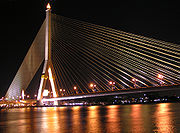 Rama VIII Bridge (Figure 2) 2002 |
 20-baht banknote (Figure 3) 2003 |
See also
- History of Thailand (1932–1973)
- French-Thai War
- Japanese Invasion of Thailand
- Free Thai Movement
References
- ↑ 1.0 1.1 Keith Simpson. Forty Years of Murder: an Autobiography, Chapter 13: The Violent Death of King Ananda of Siam, Harrap, 1978.
- ↑ Hua Hin Tourist Information, Biography of King Ananda Mahidol
- ↑ 3.0 3.1 3.2 3.3 3.4 3.5 Sulak Sivaraksa, "Powers That Be: Pridi Banomyong through the rise and fall of Thai democracy", 1999
- ↑ BBC, "Soul of a Nation", originally broadcast 1980; rebroadcast as part of Gero von Boehm, "Paläste der Macht – Herrscher des Orients: Der Sultan von Brunei und das thailändische Königshaus.", broadcast on Channel "Arte", broadcast 14 May 2008, 20.15 hrs
- ↑ William Stevenson, The Revolutionary King: : the true-life sequel to the King and I, 2001, Constable and Robinson, ISBN 1-84119-451-4.
- ↑ Kruger, Rayne (1964). The Devil's Discus. London: Cassell & Co..
- ↑ "The Devil's Discus flies away, page 156". Archived from the original on 2009-10-25. http://www.webcitation.org/5kmoix4Bx.
External links
- Bowring, Philip (10 February 2005). "Books : The Revolutionary King". International Herald Tribune. http://www.iht.com/articles/1999/12/28/bookmar.t.php.
- "Biography of King Ananda Mahidol". Hua Hin Tourist Information. http://www.huahin-tourist-information.com/chakri/rama_viii.htm. Retrieved 15 December 2005.
- Simpson, Keith (1978). Forty Years of Murder: an Autobiography. Harrap. Chapter 13: The Violent Death of King Ananda of Siam. http://web.archive.org/web/20060222062006/http://www.khunnamob.info/board/note.php?ref=m1ebrtzP. Retrieved 26 March 2008.
|
Ananda Mahidol
Chakri Dynasty
Born: 20 September 1925 Died: 9 June 1946 |
||
| Regnal titles | ||
|---|---|---|
| Preceded by Prajadhipok |
King of Siam 1935-1939 |
Country name changed to "Thailand" |
| New title Siam became "Thailand"
|
King of Thailand 1939–1946 |
Succeeded by Bhumibol Adulyadej |
|
||||||||||||||
| Office holders | Individuals and institutions | Key events | |||
|---|---|---|---|---|---|
|
The Monarchy
Prime Ministers of Thailand
|
Military
Others
Institutions |
Key events
|
|||